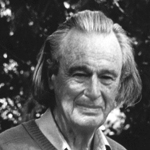
Margaret Mead was an American cultural anthropologist, author and speaker, who appeared frequently in the mass media during the 1960s and the 1970s.

Gregory Bateson was an English anthropologist, social scientist, linguist, visual anthropologist, semiotician, and cyberneticist whose work intersected that of many other fields. His writings include Steps to an Ecology of Mind (1972) and Mind and Nature (1979).

The American Anthropological Association (AAA) is an organization of scholars and practitioners in the field of anthropology. With 10,000 members, the association, based in Arlington, Virginia, includes archaeologists, cultural anthropologists, biological anthropologists, linguistic anthropologists, linguists, medical anthropologists and applied anthropologists in universities and colleges, research institutions, government agencies, museums, corporations and non-profits throughout the world. The AAA publishes more than 20 peer-reviewed scholarly journals, available in print and online through AnthroSource. The AAA was founded in 1902.

George Peter ("Pete") Murdock, also known as G. P. Murdock, was an American anthropologist who was professor at Yale University and University of Pittsburgh. He is remembered for his empirical approach to ethnological studies and his study of family and kinship structures across differing cultures.

The Lapita culture is the name given to a Neolithic Austronesian people and their distinct material culture, who settled Island Melanesia via a seaborne migration at around 1600 to 500 BCE. The Lapita people are believed to have originated from the northern Philippines, either directly, via the Mariana Islands, or both. They were notable for their distinctive geometric designs on dentate-stamped pottery, which closely resemble the pottery recovered from the Nagsabaran archaeological site in northern Luzon. The Lapita intermarried with the Papuan populations to various degrees, and are the direct ancestors of the Austronesian peoples of Polynesia, eastern Micronesia, and Island Melanesia.

Coming of Age in Samoa: A Psychological Study of Primitive Youth for Western Civilisation is a 1928 book by American anthropologist Margaret Mead based upon her research and study of youth – primarily adolescent girls – on the island of Taʻū in American Samoa. The book details the sexual life of teenagers in Samoan society in the early 20th century, and theorizes that culture has a leading influence on psychosexual development.

Sir Raymond William Firth was an ethnologist from New Zealand. As a result of Firth's ethnographic work, actual behaviour of societies is separated from the idealized rules of behaviour within the particular society. He was a long serving professor of anthropology at the London School of Economics, and is considered to have singlehandedly created a form of British economic anthropology.

Anthropology of art is a sub-field in social anthropology dedicated to the study of art in different cultural contexts. The anthropology of art focuses on historical, economic and aesthetic dimensions in non-Western art forms, including what is known as 'tribal art'.
Hiram Pendleton Caton III was a professor of politics and history at Griffith University, Brisbane, Australia, until his retirement. He was an ethicist, a Fellow of the Australian Institute of Biology, and a founding member of the Association for Politics and the Life Sciences. He was an officer of the International Society for Human Ethology. Caton held a National Humanities Fellowship at the National Humanities Center in 1982–83. He was the inaugural Professor of Humanities at Griffith University in Brisbane, and later the Professor of Politics and History and Head of the School of Applied Ethics there.
Chambri are an ethnic group in the Chambri Lakes region in the East Sepik province of Papua New Guinea. The social structures of Chambri society have often been a subject in the study of gender roles. They speak the Chambri language.

John Derek Freeman was a New Zealand anthropologist known for his criticism of Margaret Mead's work on Samoan society, as described in her 1928 ethnography Coming of Age in Samoa. His attack "ignited controversy of a scale, visibility, and ferocity never before seen in anthropology."

Sir John Rankine Goody was an English social anthropologist. He was a prominent lecturer at Cambridge University, and was William Wyse Professor of Social Anthropology from 1973 to 1984.

Educational anthropology, or the anthropology of education, is a sub-field of socio-cultural anthropology that focuses on the role that culture has in education, as well as how social processes and cultural relations are shaped by educational settings. To do so, educational anthropologists focus on education and multiculturalism, educational pluralism, culturally relevant pedagogy and native methods of learning and socializing. Educational anthropologists are also interested in the education of marginal and peripheral communities within large nation states. Overall, educational anthropology tends to be considered as an applied field, as the focus of educational anthropology is on improving teaching learning process within classroom settings.

This is a list of books in the English language which deal with Jersey and its geography, history, inhabitants, culture, biota, etc.

This is a list of books in the English language which deal with Afghanistan and its geography, history, inhabitants, culture, biota, etc.
Cyril Shirley Belshaw was a New Zealand-born Canadian Anthropologist and was professor of Anthropology at the University of British Columbia (UBC) from 1953 until his retirement in 1987. Belshaw attended New Zealand's Victoria College where he received a M.A, prior to continuing his education at the London School of Economics where he received his Ph.D. in Social Anthropology. After finishing his education, Belshaw worked as a colonial administrator and economist in the South Pacific.
May Mandelbaum Edel was an American anthropologist known for her fieldwork among the Okanagan in Washington, the Tillamook in Oregon, and the Kiga in Uganda. Edel's linguistic research of the Tillamook serves as the only published account of the language which provided data for future linguistic publications. Edel was the first American woman anthropologist to live in an African village, and her research in Africa documented the diversity of African cultures.
Jeannette Marie Mageo was an American psychological anthropologist at Washington State University. She was known for her anthropological work that focused on dreams and the self, attachment and childhood, gender and sexuality.
A Scientific Theory of Culture and Other Essays is a 1944 anthropological book by the Polish scholar Bronisław Malinowski. It was published posthumously, two years after Malinowski's death.













